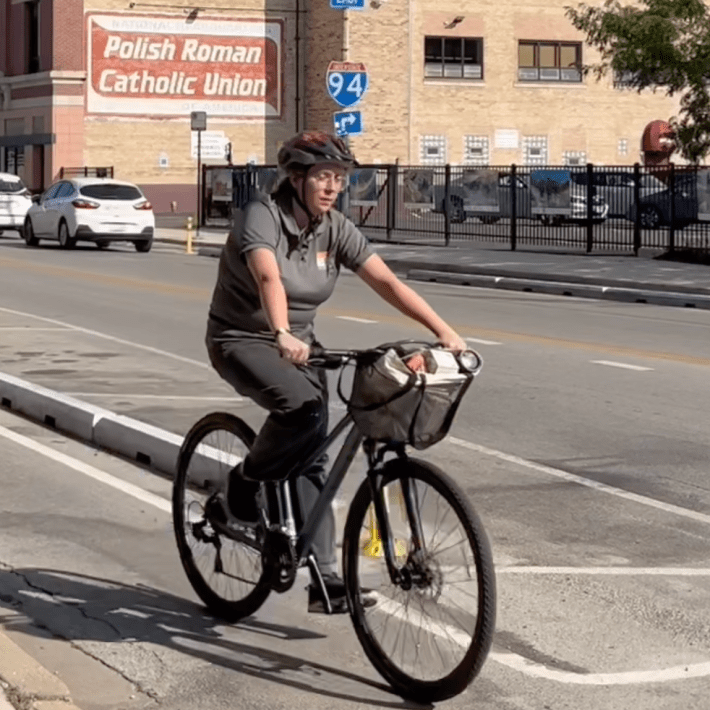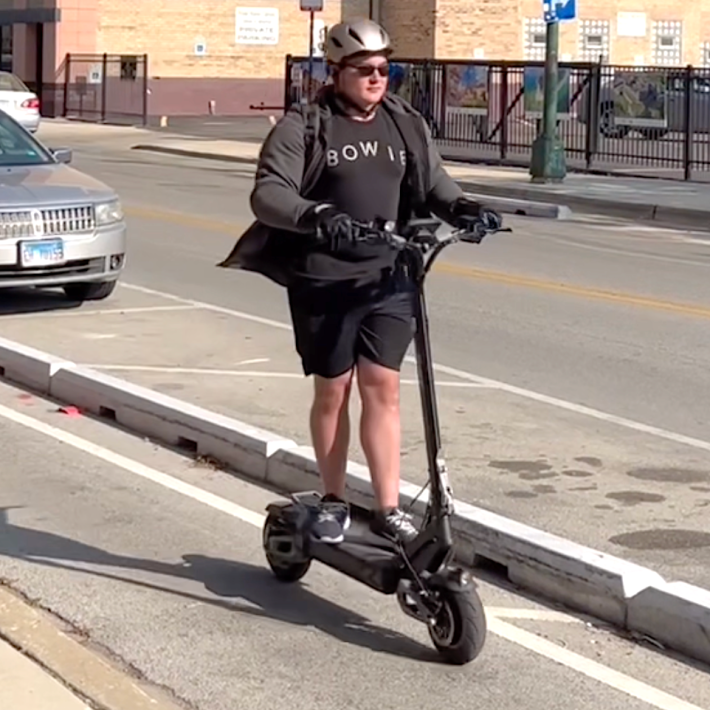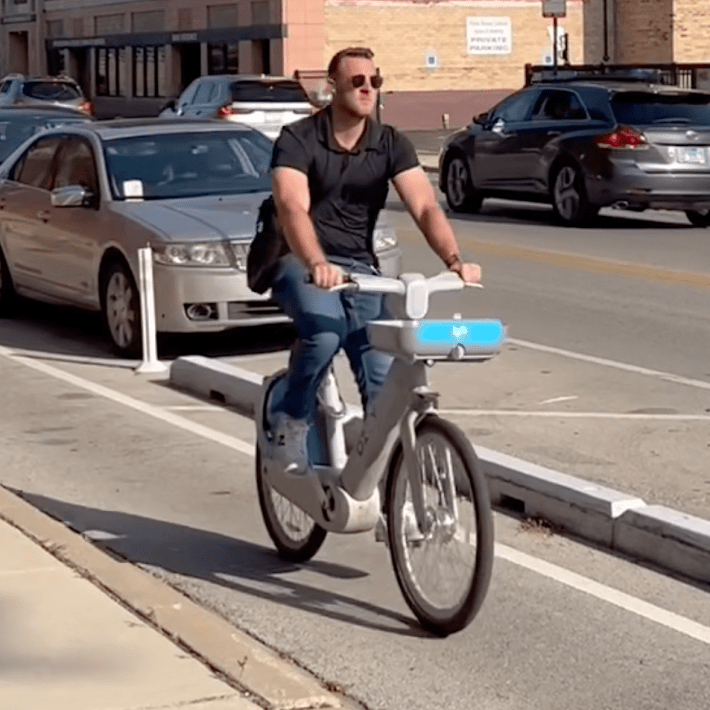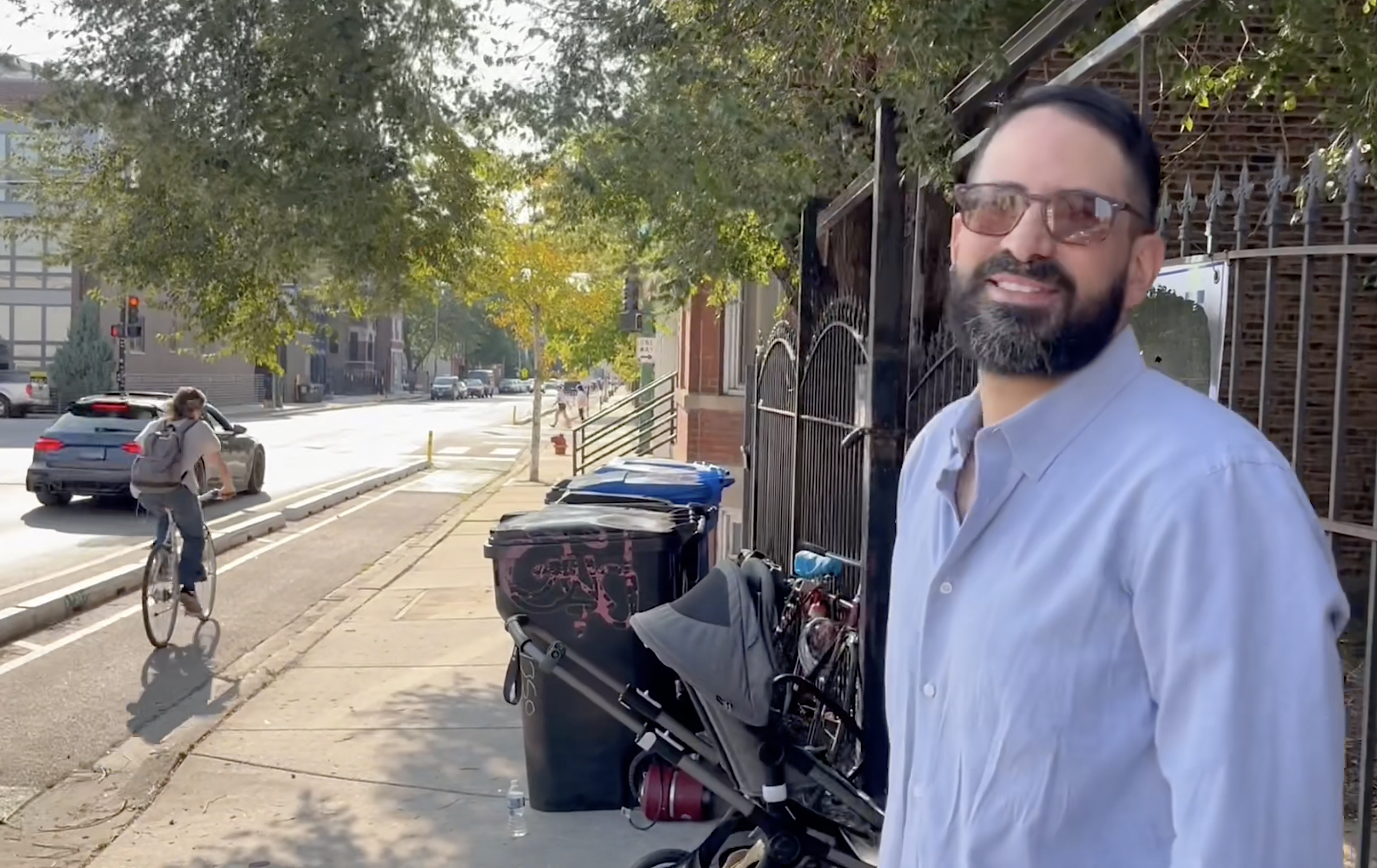
If you follow me on Twitter, you probably already know all about this experiment. Otherwise, let me quickly bring you up to speed.
How it started
On August 8, 2024, Chicago real estate professional A.J. Manaseer, who lives on Augusta Boulevard in the West Town community, tweeted the following. "The Augusta [Protected] Bike Lane in its natural state… (totally unused). I saw one guy use it last week. Since then, zero. And this is all in peak cycling weather. Imagine during the rest of year."
"I invite any of Chicago’s leading bike advocates to come sit with me there for an hour and if more than 3% of passersby are on bikes, I will donate $1000 to the charity of their choice and admit I was wrong," he added. "If not, you tweet a retraction admitting I was right that this lane is an underutilized white elephant (not to mention poorly designed and dangerous). 3% on a nice summer day, for one of the North Side’s main bike arteries. Should be easy, right?"
"The one condition," he concluded in a follow up tweet. "I choose the time and day (between 9 a.m. and 7 p.m.) and it is revealed last minute. Otherwise the bike mafia will cheat and ask people to come to skew the findings."

While there was some risk involved, I didn't want to leave that $1,000, which could potentially go to local bike education centers, lying on the table. After some reasonably civil discussion with Manaseer on twitter and elsewhere, we agreed on the following, slightly altered, ground rules for the wager, which I then tweeted out:
For the nitty-gritty of the agreement, check out the screenshots attached to the tweet above. In a nutshell, we would count the vehicle operators on Augusta for an hour on a non-rainy summer day. We'd essentially be comparing the number of people operating non-pedestrian modes allowed in Chicago protected bike lanes (bikes, e-scooters, etc.) to the number of folks driving non-permitted modes (cars, trucks, motorcycles, etc.) For Manaseer to donate the grand, 3 percent or more vehicle operators on the Augusta corridor during our count would have to be using sustainable transportation.

Manaseer generously agreed to count non-pedestrian sustainable transportation users on Augusta (the boulevard doesn't have a CTA bus route) whether or not they were in the bike lanes. However, as I'll discuss later, I ultimately decided that we should have a stricter standard than that.
Reckoning
As he originally proposed, Manaseer got to choose the date and time, Monday, September 9, between roughly 3:30 and 4:30 p.m. The weather was about 80 F and sunny, nice weather for cycling and scooting.
We decided to count from the eastern terminus of the Augusta PBLs, just west of Milwaukee Avenue. That's just west of an offramp for the Kennedy Expressway, which worked to Manaseer's advantage.

On the other hand, Milwaukee is a northwest-southwest diagonal street leading directly from recently bohemian Northwest Side neighborhoods like Logan Square and Wicker Park to the downtown Loop. Much of Milwaukee has protected lanes, and it's Chicago's busiest biking street, which is why some call it the "Hipster Highway". So counting bikes on Augusta just west of Milwaukee worked to my advantage.
Update 9/11/24, 12:50 PM: After giving this matter some thought, I think it may be more appropriate to refer to Milwaukee Avenue as the "Pierogi Promenade". I ran this idea by Metropolitan Water Reclamation District Commissioner Dan Pogorzelski, previously nicknamed "The Mayor of Avondale" for his leadership in the historically Polish-American neighborhood just north of Logan Square. He approved.

Let me say on the record, for a contest between a bikeway skeptic and an advocate, things were totally cordial. After I biked five miles from the Uptown neighborhood to the meeting place, Manaseer even offered me a bottle of cold drinking water, which I appreciated.
He counted motor vehicles, while I kept track of bikes, scooters, and a hoverboard. I shot footage of the entire one-hour session to document it. If you're short on time here’s a transcript of the start of the video, edited slightly for clarity and brevity.
John Greenfield: A.J., do you wanna tell me what you do?
A.J. Manaseer: I work in real estate here in the city of Chicago, and I live in this area. And one of the things that we have noticed lately, of course, is the protected bike lane, which, while I can recognize the benefits, there are also some costs to it. And, in my opinion, the costs kind of outweigh the benefits, given that I live here, and I walk the street every day, and I very rarely see bikers. But I see a whole lot of traffic here that’s kind of snarled and heavily inconvenienced because of the bike lanes.
So we’re here on a friendly challenge kind of experiment, to just kind of count the traffic, just out of intellectual curiosity, call it, and see what the results are.
JG: All right. [Provides a quick recap of the rules discussed and linked above.] I’m ready to start if you are. Do you want to start the clock at one hour now?
AJM: Sure. So anything that passes right in front of us is going to count then?
JG: It’s got to be on Augusta to count. It can be in or out of the bike lane. All right, so we’re ready to go?
AJM: Starting now, yep.
JG: All right, let’s go!
View the full hour-plus bike lane count video here.
I can’t promise that this video is going to be the most riveting thing in the world to watch for a solid hour, at least not while stone-cold sober. But Streetsblog Chicago readers will probably find at least a few things in the footage interesting and/or funny. Certainly, my narration gets a bit goofy at times!
Summary of results (After reviewing video):
Number of non-sustainable transportation device operators who passed us: 688
Total number of sustainable transportation device operators who passed us: 36
People on bicycles (any kind, non-electric or electric): 29
People on personal bicycles: 21
People on non-electric Divvies: 4
People on e-Divvies: 4
People on electric scooters: 6
Person on a hoverboard: 1
Person on a sustainable transportation device riding with traffic in PBL: 33
Person on a sustainable transportation device (hoverboard) in mixed-travel lane: 1
Person on a sustainable transportation device (bike) riding wrong-way in PBL: 1
Person on a sustainable transportation device (bike) riding on the sidewalk: 1
(We also saw someone riding an electric motorcycle at a high speed in a PBL, but decided not to count them.)
Conclusions
After the hour was over, we tentatively concluded that Manaseer counted 688 non-sustainable transportation device operators, while I spotted 36 sustainable transportation device operators. My review of the footage today confirmed my three-dozen number. But I have zero desire to double-check his numbers by re-counting hundreds or motor vehicles on video, so I will trust his accuracy.
So during our count, about 5 percent of vehicle operators on Augusta west of Milwaukee were using sustainable transportation devices, roughly 1.67 times the 3 percent needed for Manaseer to commit to the $1,000 donation.

But I’d like to take the high road here by acknowledging that sustainable transportation device users who aren’t riding in the protected bike lanes, or riding in them legally, don’t really help the argument that PBLs are worthwhile. So let’s not count the hoverboard user I saw in a mixed-traffic lane, or two bike riders I saw riding the wrong-way in a bike lane, and pedaling on the sidewalk.
That brings my count down to 33. So let’s call the percentage of bike and scooter using the bike lane properly as about 4.80 percent of the total traffic flow. That's still substantial, at 1.60 percent higher than 3 percent.
Here are some last thoughts on the experience from Manaseer and myself, again edited slightly for clarity and brevity.
John Greenfield: “There are no winners [today]. We both learned something. I think you deserve respect for coming out and doing this. I’ll give you even more credit it you follow through with your promise to donate $1000 to local bike education centers. [Streetsblog will update readers if this happens.] I’ll coordinate with you on that. And, as I promised, I will give you a chance to review the Streetsblog draft before publication. [I did, and Manaseer didn’t request any changes.]… Do you have anything you’d like to say?
A.J. Manaseer: Yeah, I mean, look, when I said the 3 percent number, it was kind of an enticement, not thinking that it would actually be under 3 percent. But I thought it would be pretty close, and it was. It looks like it was just under 5 percent, which is, you know, kind of what I expected it to be. I do give you credit as well for coming out here, and I can tell that you’re very passionate about biking, and I can respect that.
And look, I have nothing against bike lanes, I have nothing against bikes, I think they’re perfectly fine. The only issue I really took with this particular bike lane was just that it seemed kind of forced. I don't think they really asked the neighbors if they wanted it, and I think it could have been done a little bit better.
[The Chicago Department of Transportation held a community meeting in June 2022 to discuss the project with residents and get feedback. For those who didn't hear about the meeting or couldn't make it, the "project goals" and meeting materials were available on the initiative's CDOT webpage.]
And my whole goal with all this was to at least begin the conversation of, hey, if we're going to do this, let's at least do this in a way that maybe won't cause as many of the problems as we're seeing with this one. So maybe in the future everybody's all happy and, and [there will be] fewer conflicts in the future.
JG: OK cool. Well, thanks for… so far we both followed through with the rules, so that’s good. I didn’t tell any bicyclists to show up here. So let’s shake on the fact that we did what we said we were going to do. [We then shook hands.]
Update 9/23/24, 1:45 PM: You may disagree with A.J. Manaseer's attitude towards protected bike lanes. But, as you can see from the images below (slightly modified by Streetsblog out of an abundance of caution), after acknowledging "I lost this bet," he followed through on his promise to donate $1,000 to bike education programs. In fact, he gave 125 percent.

After a longtime Chicago bike advocate recommended four local nonprofits with currently active bicycle education programs for Manaseer to contribute to, I learned that a fifth one is currently operating a bike ed program. So I suggested that Manaseer add it to his list of $250 donations for extra credit, which he generously did. So I think we can now consider this wager, over whether or not at least 3 percent of vehicle operators on 9/9/24 between 3:30 and 4:30 p.m. on Augusta would be using sustainable transportation devices, to be productively resolved.
Gallery
Below are stills of all the images of the 33 bike and scooter riders I ultimately decided to include in the count, in order of appearance in the video.

































Did you appreciate this post? Please consider making a tax-deductible donation, to help keep Streetsblog Chicago's sustainable transportation news and advocacy articles paywall-free.




